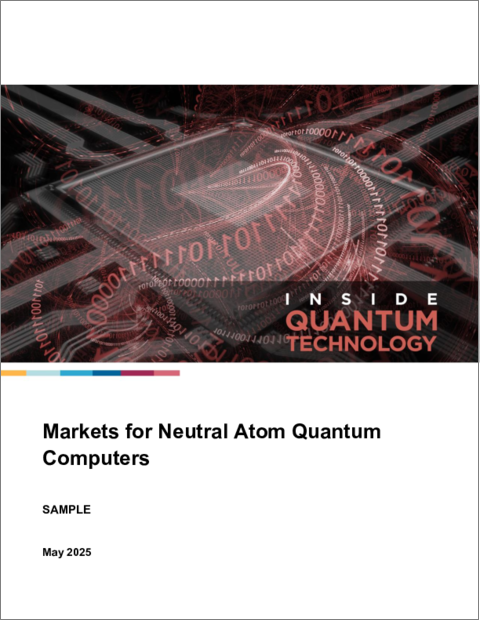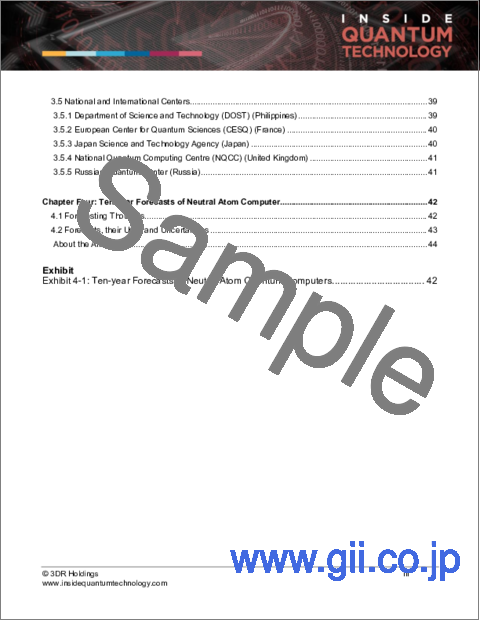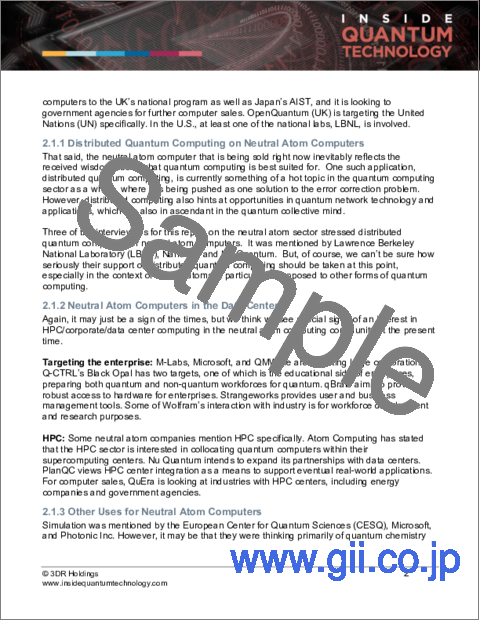|
|
市場調査レポート
商品コード
1734969
中性原子量子コンピュータ市場Markets for Neutral Atom Quantum Computers |
||||||
|
|||||||
| 中性原子量子コンピュータ市場 |
|
出版日: 2025年05月20日
発行: Inside Quantum Technology
ページ情報: 英文 48 Pages
納期: 即納可能
|
全表示
- 概要
- 目次
中性原子量子コンピュータは、支配的な超伝導量子コンピューティングパラダイムへの課題であると同時に、さらに高度なマシンへの道筋を示す「主力」量子コンピュータとして台頭してくると考えられています。2025年にはわずか8台の中性原子マシンが出荷されますが、2035年には7310台以上の中性原子マシンが出荷されるようになると見られています。
当レポート「中性原子量子コンピュータ市場」は、世界の主要な中性原子量子コンピュータベンダーの製品/市場戦略を分析しています。これには、Atom Computing、Atom Quantum Labs、Infleqtion、M Squared、OpenQuantum、Pasqal、PlanQC、QuERAが含まれます。また、チップメーカーや部品メーカーが中性原子マシンに見出している機会についても掘り下げています。チップ/コンポーネント分野で著名な企業には、AMD、浜松ホトニクス、NanoQT、Nu Quantum、QBlox、Topticaが含まれます。
当レポートでは、中性原子量子コンピュータの成功に拍車をかけている主要な技術動向についても分析しています。これらには、サイズ、重量、消費電力を改善するためのフォトニック集積回路(PIC)の使用、中性原子マシンを最適にサポートできる新しい材料プラットフォーム、中性原子マシンの大規模な政府機関や研究施設での使用からHPCやデータセンターへの移行などが含まれます。中性原子量子コンピュータにとって本当に重要なことは、$/Qubitが魅力的であり続けることです。中性原子技術は量子業界紙でますます肯定的になると予測されています。今のところ、Amazon BraketとAzure Quantumが、中性原子量子コンピュータにアクセスする唯一の一般的な方法です。
目次
第1章 中性原子技術と製品
- テクノロジーの進化
- 使用される原子
- 中性原子に対する好意的な見方が高まっている
- アクセシビリティ
- 中性原子成分
- 原子制御ハードウェアおよび読み出しコンポーネント
- 光子および写真コンポーネント
- クライオスタット
- 中性原子関連ソフトウェア
- 研究室での作業
第2章 市場と起源
- 対象用途と使用可能性
- 中性原子コンピュータ別分散量子コンピューティング
- データセンターにおける中性原子コンピュータ
- 中性原子コンピュータのその他の用途
- 制御と生態系について
- 中性原子コンピュータの供給構造
- 国家問題
- 中性原子コンピュータの世界市場と国内市場
- 関税の問題
第3章 中性原子技術
- 中性原子コンピュータ
- Atom Computing(米国)
- Atom Quantum Labs(スロベニア)
- Infleqtion(米国)
- M Squared(英国)
- OpenQuantum(英国)
- Pasqal(フランス)
- PlanQC(ドイツ)
- QuEra Computing(米国)
- 中性原子の構成要素とサブシステム
- AMD(米国)
- Hamamatsu(日本)
- Lake Shore Cryotronics(米国)
- MenloSystems(ドイツ)
- NanoQT(日本)
- Nexus Photonics(米国)
- Nu Quantum(英国)
- OpenQuantum(世界)
- Qblox(オランダ)
- Quantum Machines(イスラエル)
- Sandia National Laboratories(米国)
- Toptica Photonics(ドイツ)
- Vescent(米国)
- ソフトウェア
- アAgnostiq(カナダ)
- DarkStarStrix(ユーザー名)(米国)
- data cybernetics ssc GmbH(ドイツ)
- Lawrence Berkeley National Laboratory(LBNL)(米国)
- M-Labs(香港)
- Microsoft(米国)
- Q-CTRL(オーストラリア)
- QMWare(スイス)
- QPerfect(フランス)
- SimuQ(米国)
- Wolfram(米国)
- プラットフォーム
- Amazon Braket(米国)
- qBraid(米国)
- Strangeworks(米国)
- 国内および国際センター
- Department of Science and Technology(DOST)
- European Center for Quantum Sciences(CESQ)(フランス)
- Japan Science and Technology Agency(日本)
- National Quantum Computing Centre (NQCC)(英国)
- Russian Quantum Center(ロシア)
第4章 中性原子コンピュータの10年予測
IQT Research believes Neutral Atom Quantum Computers are emerging as "workhorse" quantum computers that are both a challenge to the dominant superconducting quantum computing paradigm and a path forward to even more advanced machines. IQT Research believes that in 2025, only eight neutral atom machines will be shipped but this number will grow to more than 7,310 neutral atom machines by 2035.
This report, "Markets for Neutral Atom Quantum Computers" analyzes the product/market strategies of the leading neutral atom quantum computer vendors worldwide. These include Atom Computing, Atom Quantum Labs, Infleqtion, M Squared, OpenQuantum, Pasqal, PlanQC, and QuERA. But we also dig into the opportunities that the chip and component makers have been finding in neutral atom machines. Prominent firms in the chip/component segment include AMD, Hamamatsu, NanoQT, Nu Quantum, QBlox and Toptica.
This report also analyzes the key technological trends that are spurring the success of neutral atom quantum computers. These include the use of photonic integrated circuits (PICs) to improve size, weight, and power consumption; novel materials platforms that can best support neutral atom machines; and the transition of neutral atom machines from large government and research facilities usage to HPC and the data center. What really matters for neutral atom quantum computers is that $/Qubit continues to be attractive. IQT Research notes that neutral atom technology is portrayed increasingly positively in the quantum trade press. For now, Amazon Braket and Azure Quantum are the only public ways to access a neutral atom quantum computer.
Table of Contents
Chapter One: Neutral Atom Technology and Products
- 1.1. Evolution of Technology
- 1.1.1. Atoms Used
- 1.1.2. Neutral Atoms Viewed Increasingly Positively
- 1.1.3. Accessibility
- 1.2. Neutral Atom Components
- 1.2.1. Atomic Control Hardware and Readout Components
- 1.2.2. Photonic and Photographic Components
- 1.2.3. Cryostats
- 1.3. Neutral Atom-related Software
- 1.3.1. Work in Research Labs
Chapter Two: Markets and Origins
- 2.1. Target Applications and Possible Uses
- 2.1.1. Distributed Quantum Computing on Neutral Atom Computers
- 2.1.2. Neutral Atom Computers in the Data Center
- 2.1.3. Other Uses for Neutral Atom Computers
- 2.2. Of Control and Ecosystems
- 2.3. Supply Structure for Neutral Atom Computers
- 2.4. National Questions
- 2.4.1. Worldwide and National Markets for Neutral Atom Computers
- 2.4.2. The Question of Tariffs
Chapter Three: Neutral Atom Technologies
- 3.1. Neutral Atom Computers
- 3.1.1. Atom Computing (United States)
- 3.1.2. Atom Quantum Labs (Slovenia)
- 3.1.3. Infleqtion (United States)
- 3.1.4. M Squared (United Kingdom)
- 3.1.5. OpenQuantum (United Kingdom)
- 3.1.6. Pasqal (France)
- 3.1.7. PlanQC (Germany)
- 3.1.8. QuEra Computing (United States)
- 3.2. Neutral Atom Components and Subsystems
- 3.2.1. AMD (United States)
- 3.2.2. Hamamatsu (Japan)
- 3.2.3. Lake Shore Cryotronics (United States)
- 3.2.4. MenloSystems (Germany)
- 3.2.5. NanoQT (Japan)
- 3.2.6. Nexus Photonics (United States)
- 3.2.7. Nu Quantum (United Kingdom)
- 3.2.8. OpenQuantum (Global)
- 3.2.9. Qblox (The Netherlands)
- 3.2.10. Quantum Machines (Israel)
- 3.2.11. Sandia National Laboratories (United States)
- 3.2.12. Toptica Photonics (Germany)
- 3.2.13. Vescent (United States)
- 3.3. Software
- 3.3.1. Agnostiq (Canada)
- 3.3.2. DarkStarStrix (username) (United States)
- 3.3.3. data cybernetics ssc GmbH (Germany)
- 3.3.4. Lawrence Berkeley National Laboratory (LBNL) (United States)
- 3.3.5. M-Labs (Hong Kong)
- 3.3.6. Microsoft (United States)
- 3.3.7. Q-CTRL (Australia)
- 3.3.8. QMWare (Switzerland)
- 3.3.9. QPerfect (France)
- 3.3.10. SimuQ (United States)
- 3.3.11. Wolfram (United States)
- 3.4. Platforms
- 3.4.1. Amazon Braket (United States)
- 3.4.2. qBraid (United States)
- 3.4.3. Strangeworks (United States)
- 3.5. National and International Centers
- 3.5.1. Department of Science and Technology (DOST) (Philippines)
- 3.5.2. European Center for Quantum Sciences (CESQ) (France)
- 3.5.3. Japan Science and Technology Agency (Japan)
- 3.5.4. National Quantum Computing Centre (NQCC) (United Kingdom)
- 3.5.5. Russian Quantum Center (Russia)
Chapter Four: Ten-year Forecasts of Neutral Atom Computer
- 4.1. Forecasting Thoughts
- 4.2. Forecasts, their Uses and Uncertainties
- About the Analyst
Exhibit
- Exhibit 4-1: Ten-year Forecasts of Neutral Atom Quantum Computers





